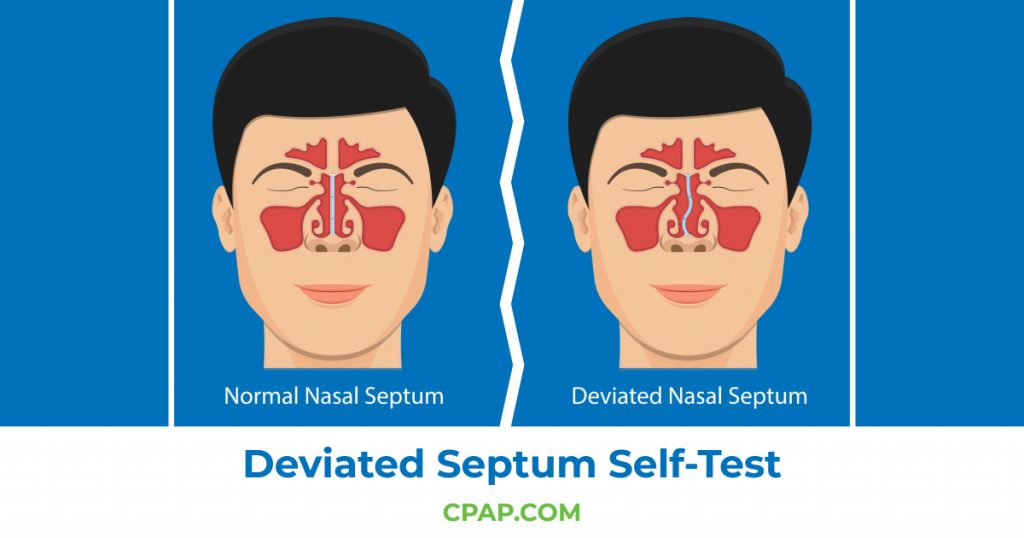
A deviated septum is a condition where the cartilage and bone that separates your nasal cavity is off-center and thus, can make breathing difficult for you. Even if your nose looks straight from the outside, you could still have a deviated septum if you are experiencing constant congestion, snoring, sinusitis, or nose bleeds—just to name a few symptoms. While having a deviated septum will not be a direct cause in the development of sleep apnea, it can worsen it if you already have sleep apnea. A deviated septum is linked to sleep apnea due to the breathing difficulties that can arise as a result of obstructions in your nostrils.
Deviated septums may be more common than you might think; the Mayo Clinic estimates that around 70% to 80% of the population has a deviated septum. However, in many cases, a deviated septum would be minor and cause no symptoms. However, in moderate to severe cases, septal deviations can cause nasal obstruction and may require treatment.
How do you know if you have a deviated septum? The good news is that you can perform a deviated septum self test from the comfort of your own home.
How To Perform a Deviated Septum Self-Test
There are two simple methods you can do at home that can help determine whether or not you may have a deviated septum.
The first is to perform a visual exam. A simple way to determine whether you have a deviated septum is to tilt your head back and look in the mirror. If you notice that the center divider of your nose—called the columella—is bent to one side or is heavily obstructing one nostril, then this could be an indication of a deviated septum.
If you’re unable to visually inspect with a mirror and have a smartphone or camera, taking a picture or recording a video of your nostrils can also be helpful as well as asking a friend of partner.
While this is an easy way to determine if something may be structurally abnormal, not all septal deviations are low enough in the columella to be visible from the underside of the nose.
The second way to test for a deviated septum at home is to perform a physical test.
- Use a finger to completely cover one nostril.
- Take a deep breath, and focus on how the air moves in and out of the nostril that is not covered.
- How easy is it for you to breathe in through that nostril?
- How much resistance do you feel to the airflow?
- Make a mental note or write down your experience to discuss with your doctor.
- Repeat steps one and two for the other nostril. Use a finger to completely cover the nostril that was previously open. Take a deep breath, and focus on how the air moves in and out of the uncovered nostril.
- After testing both nostrils individually, evaluate your experience. Was it harder to breathe through one nostril than the other?
It if was noticeably harder for air to pass through one nostril compared to the other, this may be an indication of a deviated septum.
It should be noted that this test may not be accurate if you are experiencing sinus congestion or allergies. These could serve as confounding variables that contribute to a positive test even if you don’t have a deviated septum.
The best way to tell if your nasal obstruction is from a deviated septum would be to do this test when your sinus passages are clear. Individuals with chronic sinusitis or congestion may have difficulty determining whether they have a deviated septum from a home test alone.
Regardless of your home test results, if you are experiencing trouble breathing either while you are awake or asleep, you should pay a visit to your healthcare provider.
Think You May Have Sleep Apnea? Take Our FREE Sleep Apnea Quiz!
Common Symptoms of a Deviated Septum
Symptoms of an untreated moderate to severe deviated septum include:
- Blockage of One or Both Nostrils
- Snoring or Noisy Breathing During Sleep
- Nasal or Facial Pain
- Nosebleeds
If you are experiencing one or more of those symptoms, and you feel as though you may have a deviated septum after performing the self-test, the next step would be to get tested for septal deviation by a medical professional.
Also take into account that your septum could have deviated if you’ve been injured, broken your nose in the past, or if your nose appears visibly crooked. Talk to your doctor regarding past injuries to confirm your diagnosis.
Deviated Septum Treatment Options
If you suspect that you may have a deviated septum, you may want to schedule a visit with an Ear, Nose, and Throat doctor (ENT).
Deviated septums do not go away on their own, and treatment for a moderate to severe deviated septum usually requires a procedure called a septoplasty.
ENTs or plastic surgeons can diagnose deviated septums based on a physical exam of your nose. This will include looking at both the outside and the inside of your nose.
If your deviated septum is mild and causes few symptoms, you may be able to manage or alleviate your symptoms without getting a septoplasty. Based on your symptoms, your doctor may recommend certain sleeping positions or a steroid nasal spray.
What Is s Septoplasty?
The only way to correct a deviated septum is through a surgery called a septoplasty. This is a relatively minor procedure during which a surgeon makes a small incision on one side of the columella and reshapes the septum’s bone or cartilage by pushing or pulling it into the correct place. This procedure usually does not involve breaking the nose, but some cartilage may be removed or reshaped to allow for better airflow through the nasal passages.
Septoplasties are usually performed as outpatient procedures, meaning you can go home after the operation is done. The surgery usually lasts 60 to 90 minutes.
What’s Next?
If you think you may have a deviated septum, and you’re experiencing symptoms that disrupt your breathing or your day-to-day activities, it is important to see a doctor for an official diagnosis and treatment.
Luckily, fixing a deviated septum may be an easy way to dramatically improve how you feel. A 2019 study found that individuals suffering from symptoms related to their deviated septums experienced an improvement in their quality of life after having surgery to correct their septal deviations.
If you performed a deviated septum self-test and don’t think that you have a deviated septum, it may still be useful to visit a doctor if you experience any difficulty breathing.
If you think you may have sleep apnea and aren’t sure where to start, we also offer an affordable home sleep test kit, which includes a virtual consultation with a real doctor that will be able to shed some light on whether you might be living with Obstructive Sleep Apnea.





